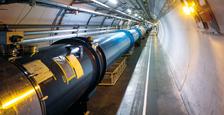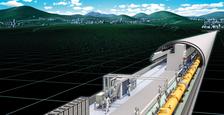DESY experts participate in the LHC experiments (Pic.: CERN)
DESY and the LHC
The proton collisions in the LHC are recorded by four giant detectors – ATLAS, CMS, ALICE und LHCb – located in large underground halls around the accelerator ring. The two biggest experiments, ATLAS and CMS, are managed by large teams of more than 2000 specialists from around the world, who jointly operate the detector and collect and analyse the data it produces. DESY itself has more than 100 experts working at ATLAS and CMS.
BELLE & BELLE II
In the big bang, matter and antimatter should have been created in equal amounts. But why is the universe today filled almost only with matter? The Belle II experiment at the SuperKEKB accelerator in Japan aims to solve this great mystery of particle physics. DESY too is involved in the ambitious experiment, which is to start operating in 2016, as well as in the data analysis of its predecessor, Belle: More information under: The Belle II Experiment
ILC: International Linear Collider - DESY Projektgruppe
The global particle physics community agrees that the discoveries made using the world’s most powerful accelerator, the Large Hadron Collider LHC at the CERN research centre in Geneva, will need to be complemented by an electron-positron accelerator. Thanks to its uniquely precise measurements, such an accelerator would reveal the secrets of the terascale – the energy realm of trillions of electronvolts (teraelectronvolts) in which the physicists expect to make decisive new discoveries – in exquisite detail. The International Linear Collider ILC, in which DESY is strongly involved, is one such future-oriented project: an approximately 35-kilometre-long linear accelerator colliding electrons and positrons at energies of between 500 and 1000 billion electronvolts (gigaelectronvolts, GeV). More information under: ILC Project group at DESY
ALPS
Researchers at DESY are interested not only in extremely heavy particles, which have to be generated by means of large high-energy accelerators; very light particles at the lower end of the energy scale can also point the way toward unknown physics phenomena. The ALPS experiment, which is tiny compared to the vast LHC and ILC facilities, is helping DESY researchers to track down such lightweights of the subatomic world. More information about: ALPS-Experiment bei DESY
Previous DESY-experiments
H1
H1 (H1-Experiment at DESY) is an international collaboration of about 400 scientisits from 39 institutes performing fundamental research in the field of High Energy Physics also known as Elementary Particle Physics. H1 collaboration has built and operated the H1 detector, a complex experiment taking data at the unique positron-proton collider HERA.
HERMES experiment
The goal of the HERMES-Experimentes is investigating the quark-gluon structure of matter: here was studied the spin structure of the nucleon. By nucleon, the protons and neutrons were reffered, which are the fundamental components of all atomic nuclei.
OLYMPUS
The DORIS accelerator at DESY was originally built for particle physics. Later, the storage ring served as a source of intense X-rays. The final experiment at DORIS marked a return to the facility’s roots: until early 2013, the OLYMPUS detector took data to find out new details about the behaviour of the proton. More information: Experiment OLYMPUS
ZEUS
Collaboration of about 450 physicists which was running a large particle detector at the electron-proton collider HERA. The ZEUS detector is a sophisticated tool for studying the particle reactions provided by the high-energetic beams of the HERA accelerator.










